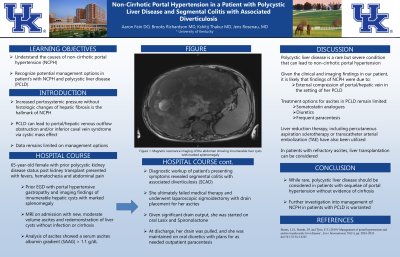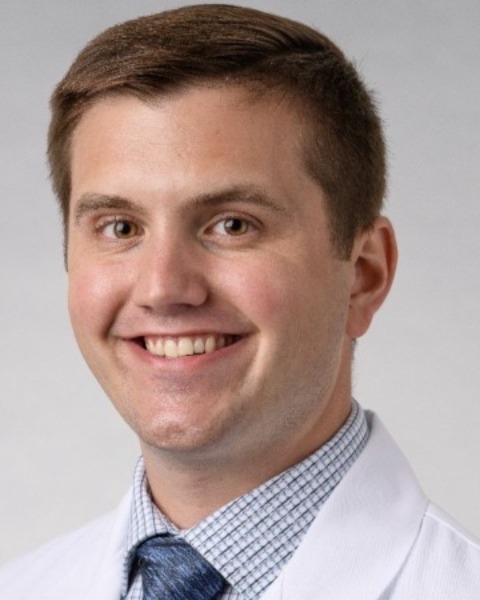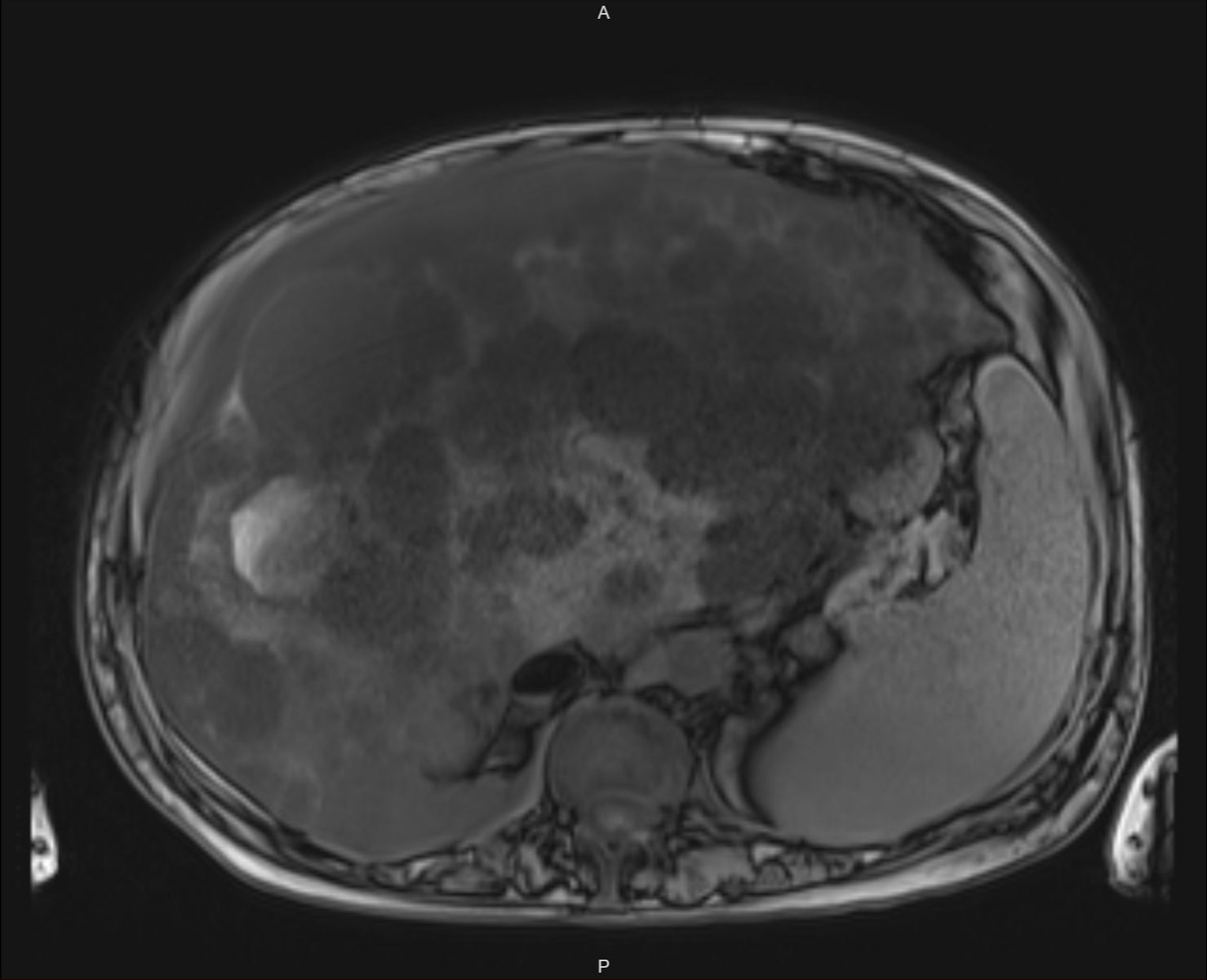Sunday Poster Session
Category: Liver
P1152 - Non-Cirrhotic Portal Hypertension in a Patient with Polycystic Liver Disease and Segmental Colitis with Associated Diverticulosis
Sunday, October 22, 2023
3:30 PM - 7:00 PM PT
Location: Exhibit Hall

Has Audio

Aaron B. Fein, DO
University of Kentucky
Lexington, KY
Presenting Author(s)
Aaron B. Fein, DO, Kshitij Thakur, MD, MSc, Brooks Richardson, MD, Jens Rosenau, MD
University of Kentucky, Lexington, KY
Introduction: Non-cirrhotic portal hypertension (NCPH) is caused by a group of disorders that increase the portosystemic pressure gradient without histologic changes of hepatic fibrosis. One potential cause is polycystic liver disease (PCLD), which can lead to portal or hepatic venous outflow obstruction and/or inferior caval vein syndrome via cystic mass effect. There is limited literature on the relationship between NCPH in PCLD and management options. We present a patient with PCLD and worsening sequelae of NCPH diagnosed with segmental colitis with associated diverticulosis (SCAD) and herein report our findings.
Case Description/Methods: A 65-year-old female with polycystic liver and kidney disease status post kidney transplantation presented to the emergency department with fevers, hematochezia, and abdominal pain. Historical findings were suggestive of portal hypertension as evidenced by a prior EGD with portal hypertensive gastropathy alongside imaging with innumerable hepatic cysts and marked splenomegaly. An MRI abdomen was obtained on admission which re-demonstrated countless liver cysts, without superimposed infection or cirrhotic liver morphology, and continued sequelae of portal hypertension with new moderate volume ascites. Labs showed thrombocytopenia and a serum ascites albumin gradient (SAAG) >1.1 g/dL. Diagnostic workup of her symptoms revealed SCAD. She failed medical therapies and ultimately required laparoscopic sigmoidectomy. A drain was placed for her ascites during surgery with significant output thereafter, for which oral furosemide and spironolactone were initiated. At discharge, her drain was pulled, and she was maintained on diuretics with plans for paracentesis as needed.
Discussion: Polycystic liver disease is a rare but severe condition that can result in portal hypertension. Our patient presented with imaging and clinical findings attributable to non-cirrhotic portal hypertension secondary to hepatic/portal vein obstruction from underlying PCLD. Treatment options for ascites in PCLD have not been well studied, though somatostatin analogues, diuretics and paracentesis have been used. Therapy aimed at reducing liver volume with percutaneous aspiration sclerotherapy or transcatheter arterial embolization (TAE) have also been utilized. For patients with refractory ascites, liver transplantation can be considered. Given our findings, further investigation into management of NCPH in patients with PCLD is warranted.

Disclosures:
Aaron B. Fein, DO, Kshitij Thakur, MD, MSc, Brooks Richardson, MD, Jens Rosenau, MD. P1152 - Non-Cirrhotic Portal Hypertension in a Patient with Polycystic Liver Disease and Segmental Colitis with Associated Diverticulosis, ACG 2023 Annual Scientific Meeting Abstracts. Vancouver, BC, Canada: American College of Gastroenterology.
University of Kentucky, Lexington, KY
Introduction: Non-cirrhotic portal hypertension (NCPH) is caused by a group of disorders that increase the portosystemic pressure gradient without histologic changes of hepatic fibrosis. One potential cause is polycystic liver disease (PCLD), which can lead to portal or hepatic venous outflow obstruction and/or inferior caval vein syndrome via cystic mass effect. There is limited literature on the relationship between NCPH in PCLD and management options. We present a patient with PCLD and worsening sequelae of NCPH diagnosed with segmental colitis with associated diverticulosis (SCAD) and herein report our findings.
Case Description/Methods: A 65-year-old female with polycystic liver and kidney disease status post kidney transplantation presented to the emergency department with fevers, hematochezia, and abdominal pain. Historical findings were suggestive of portal hypertension as evidenced by a prior EGD with portal hypertensive gastropathy alongside imaging with innumerable hepatic cysts and marked splenomegaly. An MRI abdomen was obtained on admission which re-demonstrated countless liver cysts, without superimposed infection or cirrhotic liver morphology, and continued sequelae of portal hypertension with new moderate volume ascites. Labs showed thrombocytopenia and a serum ascites albumin gradient (SAAG) >1.1 g/dL. Diagnostic workup of her symptoms revealed SCAD. She failed medical therapies and ultimately required laparoscopic sigmoidectomy. A drain was placed for her ascites during surgery with significant output thereafter, for which oral furosemide and spironolactone were initiated. At discharge, her drain was pulled, and she was maintained on diuretics with plans for paracentesis as needed.
Discussion: Polycystic liver disease is a rare but severe condition that can result in portal hypertension. Our patient presented with imaging and clinical findings attributable to non-cirrhotic portal hypertension secondary to hepatic/portal vein obstruction from underlying PCLD. Treatment options for ascites in PCLD have not been well studied, though somatostatin analogues, diuretics and paracentesis have been used. Therapy aimed at reducing liver volume with percutaneous aspiration sclerotherapy or transcatheter arterial embolization (TAE) have also been utilized. For patients with refractory ascites, liver transplantation can be considered. Given our findings, further investigation into management of NCPH in patients with PCLD is warranted.

Figure: Figure 1: Magnetic resonance imaging of the abdomen showing innumerable liver cysts with marked splenomegaly
Disclosures:
Aaron Fein indicated no relevant financial relationships.
Kshitij Thakur indicated no relevant financial relationships.
Brooks Richardson indicated no relevant financial relationships.
Jens Rosenau indicated no relevant financial relationships.
Aaron B. Fein, DO, Kshitij Thakur, MD, MSc, Brooks Richardson, MD, Jens Rosenau, MD. P1152 - Non-Cirrhotic Portal Hypertension in a Patient with Polycystic Liver Disease and Segmental Colitis with Associated Diverticulosis, ACG 2023 Annual Scientific Meeting Abstracts. Vancouver, BC, Canada: American College of Gastroenterology.
